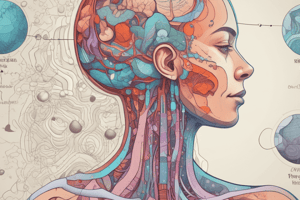Podcast
Questions and Answers
What role do minerals play in the human body?
What role do minerals play in the human body?
- They serve as a primary source of energy.
- They enhance protein synthesis only.
- They contribute to the body's organic compounds.
- They are involved in osmotic properties and structural functions. (correct)
Which of the following is classified as a major mineral?
Which of the following is classified as a major mineral?
- Iron
- Calcium (correct)
- Selenium
- Copper
What are the recommended daily intake levels for calcium in adults?
What are the recommended daily intake levels for calcium in adults?
- 1,000-1,200 mg (correct)
- 500-800 mg
- 2,500-3,000 mg
- 700-900 mg
Which factor can negatively impact calcium absorption?
Which factor can negatively impact calcium absorption?
What is the primary method for assessing calcium status in the body?
What is the primary method for assessing calcium status in the body?
Which statement accurately describes the function of NPT2b?
Which statement accurately describes the function of NPT2b?
What hormone negatively influences the regulation of serum phosphorus levels?
What hormone negatively influences the regulation of serum phosphorus levels?
Where in the body is approximately 85% of phosphorus stored?
Where in the body is approximately 85% of phosphorus stored?
What role does phospholipase C play in phosphorus metabolism?
What role does phospholipase C play in phosphorus metabolism?
Which factor significantly influences intestinal phosphorus absorption in infants and children?
Which factor significantly influences intestinal phosphorus absorption in infants and children?
What occurs when high phosphorus diets are consumed by renally compromised individuals?
What occurs when high phosphorus diets are consumed by renally compromised individuals?
Which of the following statements about phosphorus absorption in adults is correct?
Which of the following statements about phosphorus absorption in adults is correct?
What condition may occur due to severe magnesium deficiency?
What condition may occur due to severe magnesium deficiency?
Which dietary source is considered a high phosphorus food?
Which dietary source is considered a high phosphorus food?
How does magnesium sulfate (MgSO4) help in the treatment of eclampsia?
How does magnesium sulfate (MgSO4) help in the treatment of eclampsia?
What is a major function of phosphorus in the body?
What is a major function of phosphorus in the body?
What percentage of circulating phosphorus is typically complexed with calcium, magnesium, and sodium?
What percentage of circulating phosphorus is typically complexed with calcium, magnesium, and sodium?
What is the relationship between magnesium intake and cardiovascular disease?
What is the relationship between magnesium intake and cardiovascular disease?
What is a characteristic symptom of preeclampsia?
What is a characteristic symptom of preeclampsia?
What does urinary phosphorus levels generally reflect under normal conditions?
What does urinary phosphorus levels generally reflect under normal conditions?
Flashcards
What are minerals and why are they important?
What are minerals and why are they important?
Minerals are inorganic elements vital for life, comprising approximately 4% of body weight. They play critical roles in various functions like maintaining fluid balance, building bones and teeth, regulating body processes, and acting as cofactors for enzymes.
What are major minerals and what are some examples?
What are major minerals and what are some examples?
Major minerals, also known as macrominerals, are required in larger quantities by the body. These include calcium (Ca), phosphorus (P), magnesium (Mg), sodium (Na), potassium (K), chloride (Cl), and sulfur (S).
What are the major functions of calcium in the body?
What are the major functions of calcium in the body?
Calcium is crucial for strong bones and teeth, nerve transmission, muscle contraction, blood clotting, enzyme regulation, and maintaining cell membrane function.
How is calcium absorption regulated in the body?
How is calcium absorption regulated in the body?
Signup and view all the flashcards
What are the consequences of calcium deficiency?
What are the consequences of calcium deficiency?
Signup and view all the flashcards
What is NPT2a?
What is NPT2a?
Signup and view all the flashcards
What is NPT2b?
What is NPT2b?
Signup and view all the flashcards
What is NPT2c?
What is NPT2c?
Signup and view all the flashcards
Name three primary hormones regulating phosphorus metabolism.
Name three primary hormones regulating phosphorus metabolism.
Signup and view all the flashcards
How is phosphorus released from phospholipids during digestion?
How is phosphorus released from phospholipids during digestion?
Signup and view all the flashcards
What enzyme hydrolyzes phosphorus bound to organic molecules?
What enzyme hydrolyzes phosphorus bound to organic molecules?
Signup and view all the flashcards
How is most dietary phosphorus absorbed?
How is most dietary phosphorus absorbed?
Signup and view all the flashcards
What is the range of phosphorus absorption in infants, children, and adults?
What is the range of phosphorus absorption in infants, children, and adults?
Signup and view all the flashcards
How does phosphorus exist in the bloodstream?
How does phosphorus exist in the bloodstream?
Signup and view all the flashcards
Where is most of the body's phosphorus stored?
Where is most of the body's phosphorus stored?
Signup and view all the flashcards
How do kidneys regulate serum phosphorus levels?
How do kidneys regulate serum phosphorus levels?
Signup and view all the flashcards
How do PTH, FGF23, and calcitriol influence phosphorus reabsorption in the kidneys?
How do PTH, FGF23, and calcitriol influence phosphorus reabsorption in the kidneys?
Signup and view all the flashcards
What effect can a high phosphorus diet have on individuals with kidney problems?
What effect can a high phosphorus diet have on individuals with kidney problems?
Signup and view all the flashcards
How does urinary phosphorus relate to absorbed phosphorus under normal conditions?
How does urinary phosphorus relate to absorbed phosphorus under normal conditions?
Signup and view all the flashcards
What are the main functions of phosphorus in the body?
What are the main functions of phosphorus in the body?
Signup and view all the flashcards
Study Notes
Minerals in the Body
- Minerals represent about 4% of total body weight
- Involved in body fluid osmotic properties, bone & teeth structure, body process regulation, and metalloenzyme cofactors
- Classified as major (macrominerals) and minor (microminerals)
- Major minerals include calcium (Ca), phosphorus (P), magnesium (Mg), sodium (Na), potassium (K), chlorine (Cl), and sulfur (S)
- Minor minerals include iron (Fe), copper (Cu), zinc (Zn), manganese (Mn), selenium (Se), iodine (I), molybdenum (Mo), and chromium (Cr)
- Calcium, phosphorus, and magnesium are vital for bone mineralization, nerve transmission, muscle contraction, blood clotting, enzyme regulation, and membrane permeability
- Good calcium sources include milk, cheese, yogurt, canned salmon, fortified cereals, juices, and plant-based milks
- Calcium absorption is regulated by calcitriol, passive paracellular transport, calbindin D9k, and Ca-ATPase pump
- Factors (oxalate, phytic acid, etc.) can enhance or inhibit calcium absorption
- Hormones (vitamin D, parathyroid hormone (PTH), calcitonin) regulate calcium homeostasis
- Recommended daily calcium intake is 1000-1200mg for adults; upper limit 2000-2500mg
- Calcium deficiency can lead to muscle tetany, osteopenia, osteoporosis, etc.
- Bone densitometry (DEXA) is the most reliable method for assessing bone mineral content
- Phosphorus (PO42-) is the second most common inorganic element
- Sources include meat, fish, dairy, nuts, legumes, cereals, and those with added phosphoric acid.
Phosphorus Metabolism
- Most dietary phosphorus is absorbed passively in the small intestine (65%-90% in infants/children; 55%-80% in adults)
- Phosphorus is quickly absorbed and exists as HPO42-, complexed with other minerals, or bound to protein
- 85% is stored in the skeleton; most is excreted in urine, with some in feces
- Phosphate absorption in the kidney is regulated by PTH, FGF23, and potentially calcitriol.
- NPT2a, NPT2b, and NPT2c are key transport proteins in phosphate regulation, mainly in the kidney and small intestine (especially NPT2b)
Magnesium and Its Functions
- A major role in cardiovascular health; some studies have shown lower mortality in populations consuming magnesium-rich water.
- Inverse association between circulating magnesium levels and risk of cardiovascular disease, hypertension, and type 2 diabetes
- May benefit endothelial function in those with cardiovascular disease
- Important in Preeclampsia/Eclampsia: Magnesium sulfate (MgSO4) is a common treatment to prevent eclamptic seizures and possibly limit cerebral edema
- Relevant for osteoporosis, bone mineral density, interactions with vitamin D (in older adults)
- Benefit for headaches, migraines, and asthma (limited data on chronic asthma or oral supplements).
Studying That Suits You
Use AI to generate personalized quizzes and flashcards to suit your learning preferences.



